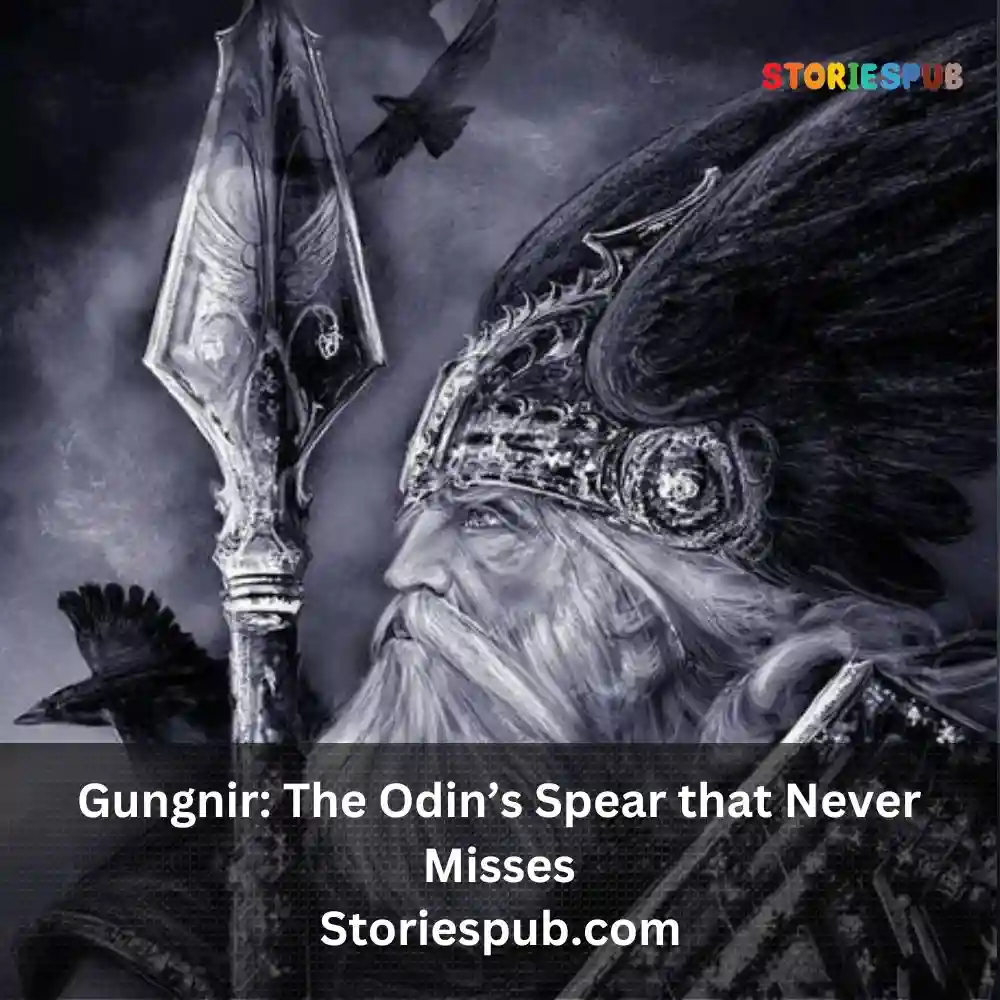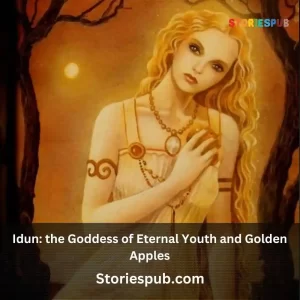Gungnir: The Odin’s Spear that Never Misses

Image credit : Pinterest
The Mighty Gungnir: The Spear of Odin
Norse mythology is rich in tales of Gods and their weapons. One such weapon of mythical proportions is Gungnir, the spear of Odin – the Allfather.
Odin is one of the principal Gods in Norse mythology, revered for his wisdom, magic, and martial prowess. He was considered the leader of the Aesir clan and was believed to reside in Asgard – the realm of Gods.
The Importance of Norse Mythology and Odin
Norse mythology has been fascinating people for centuries with its vivid stories. This complex system of beliefs originated from Scandinavia and spread throughout Europe during the Viking Age (8th-11th century AD).
At its core, Norse mythology is a system that encompasses a variety of deities who interact with each other through stories, myths, and legends. These tales often depict gods engaged in epic battles or quests.
Odin was one such deity who embodied many aspects that were important to ancient Norse society; he was a God associated with war, wisdom, death, magic, poetry and prophecy. He was also seen as a protector figure – guardian to all those who followed him.
The Creation Story behind Gungnir
According to Norse mythological stories collected from “The Poetic Edda” (a collection poems) and “The Prose Edda” (a collective guide), Gungnir wasn’t just any ordinary spear – it had special powers bestowed upon it by dwarves who created it for Odin himself. A story mentions that one day while Odin was out wandering across Midgard (the world where humans lived), he stumbled upon two dwarves named Sindri and Brokkr.
They were famous for their crafting skills which they used to create magnificent objects of power. Odin then challenged them to create a weapon that would be “the mightiest on earth” but only gave them a limited amount of time to complete the task.
The dwarves set to work and crafted Gungnir out of pure gold. They imbued it with their magical powers, making it so that it always hit its target, no matter how difficult or distant.
They even added an enchantment so that the spear would always return to Odin’s hand after being thrown. Thus, Gungnir became one of the most powerful weapons in Norse mythology.
The Significance of Gungnir in Norse Mythology
Gungnir represented more than just a weapon in Norse mythology – it was a symbol of Odin’s power and authority as the leader of the Gods. Odin used Gungnir in countless battles and conflicts against his enemies, including giants and other Gods such as Thor (his own son), who was tasked with defending Midgard from threats. The mythological tales also mention how Gungnir played an instrumental role in shaping the future – for example piercing through Loki’s son Hodor when he transformed into a dragon-like creature during Ragnarok, which is considered as one of the end-times event for Norse mythology.
The Legacy of Gungnir
Gungnir has been depicted countless times throughout history – from ancient Viking artwork to modern-day pop culture references. Its iconic design has inspired many artists, movie-makers and game developers across different genres.
Gungnir is not just any ordinary spear but a symbol representing something much more significant – Odin’s power and legacy as Aesir God. Through centuries since its creation by dwarves until today, it continues to captivate people’s imagination with its rich history and legend.
The Creation of Gungnir
Mythical Story of How Gungnir Was Created by Dwarves
In Norse mythology, the creation of Gungnir is an interesting and unique tale. According to the legends, the god Odin visited the dwarves in their underground realm of Svartalfheim to commission them to create a spear that would be unmatched in all the worlds.
The dwarves agreed to craft this weapon for him and began their work. As they hammered away at the metal, they infused it with powerful magic that would make it never miss its target.
The dwarves also added intricate designs and patterns into the spear’s shaft, making it both beautiful and deadly. When they finished crafting Gungnir, they presented it to Odin with great pride.
Description of Its Unique Features, Including Never Missing Its Target
One of the most unique features of Gungnir is its ability to never miss its target. This magical attribute can be credited to both Odin’s own magical powers as well as those imbued by the dwarves during its creation.
The spear is said to always find its mark, no matter how far away or how well-hidden a target may be. Aside from this special ability, Gungnir is also known for being incredibly sharp and durable.
It was said that no shield or armor could withstand a direct hit from this weapon without some sort of magical protection. Indeed, many battles were won thanks to Odin’s use of his powerful spear.
But perhaps one of the most impressive aspects of Gungnir lies not only in its physical features but also in what it represents symbolically. As an extension of Odin himself, who was considered the greatest warrior amongst all gods and men alike, Gungnir embodied strength, power, and authority like no other weapon could.
In fact, some myths even state that the spear had a will of its own, and would seek out its targets with a fierce determination. This made it not only a fearsome weapon in battle, but also a symbol of Odin’s unwavering resolve and dedication to his cause.
Overall, Gungnir is truly a remarkable weapon with an intriguing history behind it. Its creation by the dwarves and its unique magical qualities all add to the mystique that surrounds this legendary Norse artifact.
The Significance of Gungnir in Norse Mythology
Odin’s Mighty Weapon
Gungnir was more than just a weapon to Odin, it was a symbol of his power and authority. As the king of the gods, Odin needed a weapon that could match his immense strength.
Gungnir not only provided him with an unerring aim but also served as a symbol of his divine right to rule. The spear became an extension of Odin’s being, reflecting not only his physical prowess but also his mental and spiritual power.
Gungnir in Battle
Odin used Gungnir extensively in battle. It is said that when he threw the spear, it would never miss its target.
Its magical properties made it impossible for anyone or anything to escape its path once thrown. The legend goes that Odin once threw Gungnir over an army of giants, and the spear went through every single one of them without stopping until it hit its intended target.
Gungnir in Mythology
There are many stories and myths involving Gungnir throughout Norse mythology. One such tale involves Loki’s son Baldr, who was invulnerable to all weapons except mistletoe.
With this knowledge, Loki crafted a dart made from mistletoe and gave it to Baldr’s brother Hodr during one of Odin’s feasts. Hodr unknowingly threw the dart at Baldr during a friendly game, killing him instantly.
After Baldr’s death, the gods searched for any weapon capable of killing Hodr in revenge for what he had done. Only Gungnir was able to slay Hodr because it could pierce through anything; even rock and metal were no match for its might.
Gungreidhir: The Spear That Always Returns
Another myth involving Gungnir centers around a unique property of the spear. According to legend, when Odin threw Gungnir, it would always return to his hand. However, there was one instance where this did not happen.
During a battle with the god Heimdallr, Odin threw Gungnir with such force that it broke in two. The remaining pieces were given to the dwarves who crafted them into a new weapon called Gungreidhir: The Spear That Always Returns.
Symbol of Authority
In Norse mythology, Gungnir also served as a symbol of authority and power for those who wielded it. When someone was given the honor of carrying Odin’s spear, they were imbued with divine right and authority over others.
This is exemplified in stories such as when Odin bestowed the spear upon his son Thor, giving him immense power and authority among the gods. Gungnir was more than just a weapon in Norse mythology; it was a symbol of power and authority for those who wielded it.
Its magical properties made it an unbeatable weapon on the battlefield and its association with Odin gave its holder divine right over others. Stories and myths involving Gungnir showcase its mighty strength throughout Norse mythology and continue to captivate audiences today.
The Legacy of Gungnir
From Mythology to Art
Gungnir has been a source of inspiration for artists for centuries. From ancient Norse art to modern-day comics, Gungnir has made its way into various forms of visual art. One famous depiction is in the 13th century Poetic Edda, where it is described as having a “glittering point” and being adorned with precious stones.
This description has influenced many artistic representations of Gungnir, often featuring ornate designs and intricate embellishments. In addition to visual art, Gungnir has also been referenced in music and literature.
A prime example is Richard Wagner’s opera cycle “The Ring of the Nibelung,” where Gungnir plays a significant role in the story. The opera’s use of Gungnir as a symbol for power and authority has had a lasting impact on how people perceive Odin’s spear.
Gungnir in Popular Culture
Gungnir’s influence extends far beyond just art and literature – it can also be found in popular culture today. From video games like “Assassin’s Creed Valhalla” to Marvel Comics’ Thor series, Gungnir continues to inspire creators across different mediums. One notable example is its appearance in the popular television series “Vikings.” Here, we see the character Ragnar Lothbrok wield his own version of the spear – a testament to how deeply ingrained Gungnir is within Viking culture.
Influence on Modern Weapons
Beyond just cultural influence, there are those who have taken inspiration from Gungnir’s unique abilities when designing modern weapons. One possible example can be seen with smart bullets – a technology that allows bullets to adjust their trajectory mid-flight based on an algorithm set by the shooter. These bullets, like Gungnir, are designed to never miss their target.
In fact, Gungnir has even inspired the naming of modern-day weapons. The US military has a missile defense system called “Gungnir,” which is designed to intercept enemy missiles with pinpoint accuracy.
The Continuing Legacy of Gungnir
Overall, it’s clear that Gungnir’s legacy continues to live on in various forms today. From its influence on art and culture to its impact on modern weapon design, Gungnir remains an iconic symbol of power and precision. Its enduring significance is a testament to the enduring power of Norse mythology and the enduring fascination with Odin’s legendary spear.
Conclusion
Recap on the importance and significance of Gungnir in Norse mythology
Throughout Norse mythology, Gungnir symbolized not only Odin’s power and authority but also his connection to wisdom and knowledge. The spear’s unique ability to always hit its mark made it an indispensable weapon in battles, and its mythical creation by dwarves added to its supernatural qualities. Gungnir’s importance is further highlighted by the number of myths and stories that feature it, including the tale of how it pierced through the heart of Loki’s son, as well as its frequent depiction in art and literature.
Reflection on how this mythical weapon continues to captivate people’s imagination today
Despite being a relic from ancient mythology, Gungnir continues to fascinate people today because of its unique characteristics. The idea that a weapon could never miss its target is something that has captivated human imagination for centuries. It has become somewhat iconic in popular culture as well, being referenced in movies like Thor: Ragnarok or TV shows like Vikings.
Furthermore, the legend surrounding Gungnir speaks to a broader human fascination with mythology itself. These stories are not just entertainment but also have deep roots in human culture, traditions, and beliefs.
They explore fundamental questions about human nature and offer insights into our past while simultaneously inspiring us with wonder about what might still be possible. In many ways, the continued appeal of weapons like Gungnir is representative of our constant search for meaning across cultures and generations.
As we look back at these ancient myths today with fresh eyes from a modern perspective, we can still find messages that resonate with us deeply. Overall, while few people today would use or even need a weapon like Gungnir (we hope!), this legendary spear remains an important part of Norse mythology because it embodies some fundamental aspects of human nature that continue to captivate our imagination today.
Hey kids, how much did you like The Gungnir: The Odin’s Spear that Never Misses? Please share your view in the comment box. Also, please share this story with your friends on social media so they can also enjoy it, and for more such Norse Mythology, , please bookmark storiespub.com.
Related Post :
Gungnir FAQ
Who created Gungnir?
Gungnir was created by the dwarves known as the Sons of Ivaldi, who were renowned for their exceptional craftsmanship.
How did Odin acquire Gungnir?
Odin acquired Gungnir from the dwarf Dvalin, who presented the spear to the god as part of a contest between two groups of dwarves.
What are the magical properties of Gungnir?
Gungnir is said to be perfectly balanced, unerringly accurate, and able to penetrate any armor or barrier.
What role does Gungnir play in Norse mythology?
Gungnir is associated with Odin's role as a god of war and wisdom and often symbolizes his authority and power.
How is Gungnir related to the world tree Yggdrasil?
Gungnir was used by Odin to sacrifice himself to himself by hanging from Yggdrasil, the world tree, in order to gain knowledge of the runes.
Is Gungnir featured in any famous Norse myths or sagas?
Gungnir is mentioned in several Norse sources, including the Poetic Edda, Prose Edda, and various sagas, such as the Volsunga Saga.
What does the name "Gungnir" mean?
The name "Gungnir" translates to "swaying one" or "the one that trembles" in Old Norse, likely referring to the spear's motion when thrown.
How is Gungnir represented in modern popular culture?
Gungnir has been featured in various movies, video games, and literature, often as a powerful weapon or symbol of divine authority.
Are there any real-life weapons inspired by Gungnir?
While no exact replicas exist, the concept of an unstoppable, perfectly balanced spear has likely influenced the design of various weapons throughout history.



